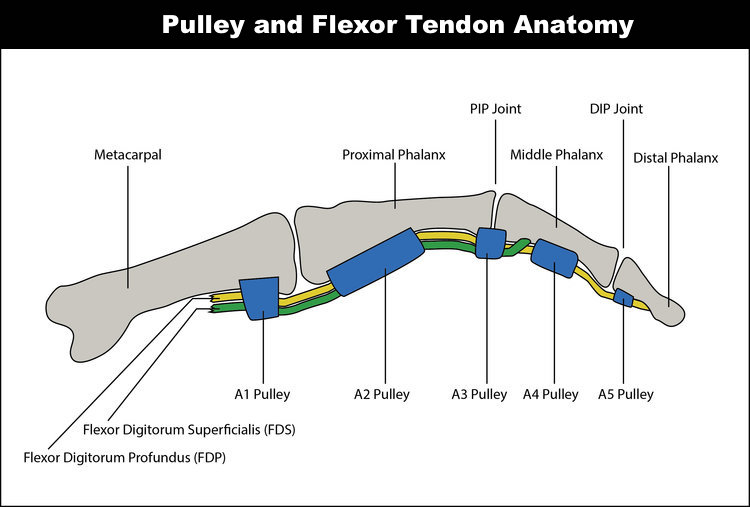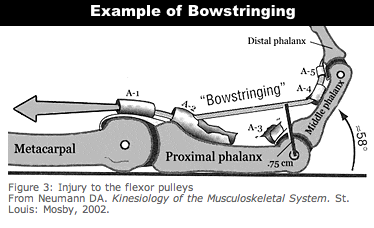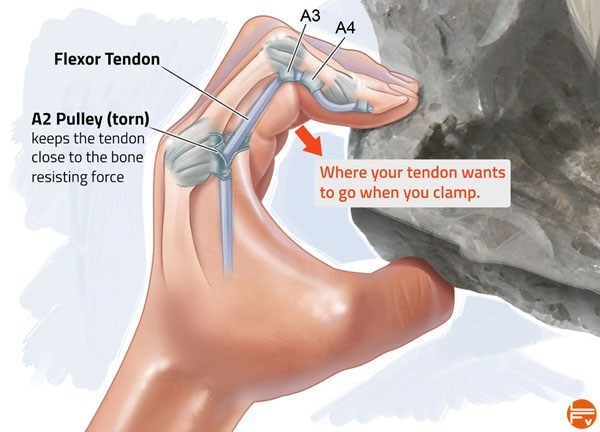Flexion pulley injury for rock climbers
Fingers are very important, they help use hold things, they help us use a pen, they’re used for typing and all sorts of other meticulous tasks.
Rock climbers and bouldering alike, for those who heavily rely on their flexor components to hold up their body will be at a higher susceptibility to injure A2 and A4 pulleys of the flexor tendon. Although this kind of injury is uncommon amongst the whole spectrum of possible injuries we still see certain individuals present with this problem.
The crimp grip alongside the growing popularity of climbing has seen increase in injuries of the A2 pulley. One study reported a 58% incidence of flexor pulley injury as a result of rock climbing in a sample size of 623 patients, and of those patients, 52% involved the middle finger and 50% involved the A2 pulley.


what is it?
Now that I’ve mentioned pulleys a lot, many of you are probably wondering what they are. In our hand there are muscles, for both flexion and extension. Thinking about flexion alone, these pulleys are fibrous bands of thickened deep fascia (retinaculum) that help stabilise the tendon. You may think of it as using a rubber band to fasten two sticks together. These fibrous bands help our flexor tendon adhere to the contours of our fingers, so that the tendon bends just as we would like it to whether we’re holding onto a rock/bouldering hold.
When flexor pulley systems break or sprain, the retinaculum (fibrous band) loosens and the tendon is free to act. When this happens a bow string deformity occurs; and why it is called a bowstring deformity, simply because the tendon gaps away from the bone itself resembling the shape of a bow. If you have this injury, you will understand from first-hand experience (pun not intended) that this is accompanied by uncomfortable pain, due to swelling around the local area and irregularity as your natural hand kinematics has been altered.

Since there are 5 pulleys to each finger, labelled A1 – 5, a bowstring deformity may happen at any one pulley. However the avid climber might be interested to know that:
- A1, 3 and 5 are attached to more stury volar plates and are rarely torn
- A2 and 4 pulleys are fastened on to periosteum and are likely to be sprained or even torn (ruptured).
- This is because the A2 pulley is considered to be the most crucial due to its significant load-bearing capabilities.
Signs and symptoms
The first signs and symptoms of a flexion pulley injury is the immediate pain surrounding any of the pulleys in your flexor component. If it is a strain there may not be any audible or palpable pop. However, if there a felt and heard pop, there may be a higher chance that the pulley is completely ruptured – this may occur during rock climbing under high load, or even catching your finger in someone’s garment during jiu-jitsu practice.
Following this, it is reported that a closed fist will be painfiul and difficult to make a full composite fist with all fingers
Solution
Management depends on the grade of the sprain:
Grade 1: pulley sprain – No need for immobilization. Followed by gentle range of motion and low grade isometric holds.
Grade 2: Complete A4 or partial A2 – Two weeks immobilisation using a split, silicon ring or pulley-protection splint. Gentle range-of-motion exercises. Graded approach back to finger weight bearing
Grade 3: Complete A2 – Immobilisation for two weeks followed with a 6 month graded program.
Grade 4: multiple pulley rupture – surgical intervention.

Conclusion.
If unsure whether this injury has happened to you, I would strongly advise to see your local physiotherapist to understand what diagnosis you may have. As there are many differential diagnosis to a basic finger injury or a variable degree of severity, it is important that you seek the right advice early.
Written by Joshua Shum Physiotherapist
